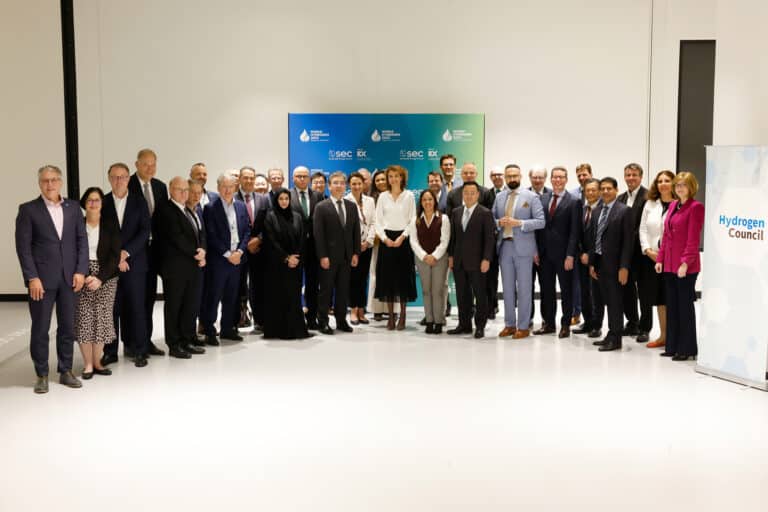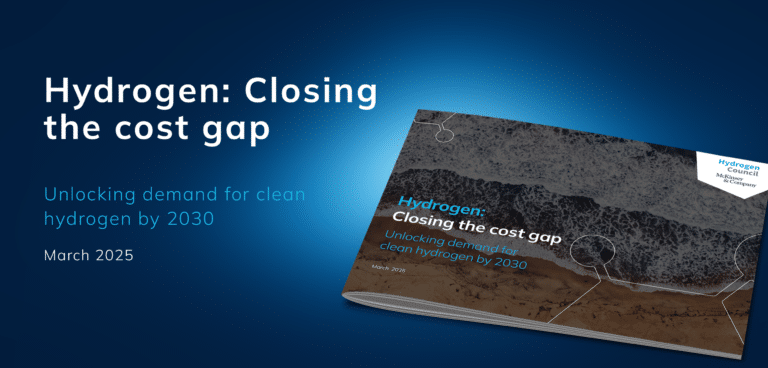- Hydrogen and its derivatives will become heavily traded: 400 out of the 660 million tons (MT) of hydrogen needed for carbon neutrality by 2050 will be transported over long distances, with 190 MT crossing international borders.
- In a cost-optimal world, around 50% of trade uses pipelines, while synthetic fuels, ammonia and sponge iron, transported on ships, account for approximately 45%. Europe and countries in the Far East will rely on imports, while North America and China are mostly self-reliant.
- Trade has huge benefits: It can lower the cost of hydrogen supply by 25%, or as much as US$6 trillion of investments from now until 2050. This will accelerate the hydrogen transition, which can abate 80 gigatons of CO2 until 2050.
BRUSSELS, October 5, 2022 – Long-distance and cross-border trade in hydrogen will play a key role in matching the lowest cost supply of hydrogen with demand in the most cost-effective manner at global level, the Hydrogen Council’s new report Global Hydrogen Flows released today highlights.
While helping accelerate the transition to net zero, long-distance and international hydrogen trade flows can reduce the total system costs across the hydrogen value chain by as much as US$6 trillion, as shown in the new report, co-authored by McKinsey & Company.
The report combines the global industry data from the Hydrogen Council with a bespoke advanced-analytics optimization model, specifically developed for the study, that balances supply and demand across all regions, multiple carriers, end products and scenarios.
Out of 1.5 million potential trade routes, the report identifies more than 40 prospective trade routes of hydrogen (or hydrogen equivalent derivatives), with the capacity to transport more than one million tons per annum by ship or pipeline.
The study identifies distinct patterns for hydrogen trade. Pure hydrogen is expected to be a ‘regional’ business and will be predominantly sourced domestically or piped from nearby regions, and only shipped via a carrier (ammonia, liquid hydrogen or LOHC) if the prior options are not available. However, hydrogen derivatives including ammonia for end use, methanol, synthetic kerosene and direct reduced iron will be shipped around the world given relatively low transportation costs, compared to production costs.
The evolution of hydrogen trade flows is expected to take place in four distinct phases, beginning with hydrogen derivative shipping by 2025, followed by the emergence of long-distance hydrogen pipelines by 2030, shipping and pipeline reaching scale by 2040, and a fully mature traded market by 2050.
Tom Linebarger, Executive Chairman and Chairman of the Board of Cummins Inc. and Co-Chair of the Hydrogen Council, said, “This report is part of the Hydrogen Council’s continued efforts to progress the conversation and policy impacting deployment of hydrogen solutions around the world. In particular, this report highlights the importance of trade and the role that hydrogen will play to decarbonize energy systems globally at a massive scale, and proposes some promising solutions to do just that.”
Yoshinori Kanehana, Chairman of Kawasaki Heavy Industries, Ltd. and Co-Chair of the Hydrogen Council, said, “The study shows that some 60% of the total volumes of clean hydrogen needed to support our global net zero targets will have to be transported over long distances. This reinforces the urgent need for advancing the development of mutually recognised robust and tradeable certification schemes for hydrogen – an issue we are actively working on in the Hydrogen Council together with our international partners.”
Bernd Heid, Senior Partner at McKinsey & Company, said, “Hydrogen and its derivatives will become widely traded, reducing supply costs by as much as 25%. This means we now need to develop the pipeline, shipping and conversion infrastructure for a renewable energy system – by 2040 more than 100 million tons (MT) of hydrogen can be transported through pipelines, and by 2050 shipping of hydrogen and derivatives will be similar in size to LNG today.”
Global Hydrogen Flows analysis shows that China, India, Japan, South Korea, Europe and North America will account for 75% of global hydrogen demand. China emerges as the largest consumer in the years to come. Production costs and volume potential vary widely between regions and some of the best producing regions are distant from the main consumption areas. For instance, some regions, such as Chile and the Middle East, will have a cost-competitive advantage over others, and 33% of produced hydrogen will be at a production cost of less than $1/kg. As a result, trade flows will develop to link competitive supply locations with demand centres.
To enable trade, US$150 billion of investments will be needed by 2030, scaling to US$1.5 trillion by 2050 on a cumulative basis. For comparison, annual investments into the global energy infrastructure today amount to US$500 billion annually. Scenario analysis also shows that both low-carbon and renewable hydrogen in combination with long-distance trade is key to meeting net-zero emissions with minimal costs. Investment costs are 13-15% higher in scenarios of lesser trade or restricted low-carbon hydrogen.
The Global Hydrogen Flows report expands a series of industry reports co-authored by the Hydrogen Council and McKinsey, including the 2020 Path to Hydrogen Competitiveness report, which explored the costs and economic benefits of hydrogen as a decarbonization vector, and the Hydrogen for Net Zero report, which stipulated overall demand growth in line with 2050 net-zero objectives.
View and download the Report
About The Hydrogen Council
The Hydrogen Council is a global CEO-led initiative that brings together leading companies with a united vision and long-term ambition for hydrogen to foster the clean energy transition. The Council believes that hydrogen has a key role to play in reaching our global decarbonization goals by helping to diversify energy sources worldwide, foster business and technological innovation as drivers for long-term economic growth, and decarbonize hard-to-abate sectors.
Using its global reach to promote collaboration between governments, industry and investors, the Council provides guidance on accelerating the deployment of hydrogen solutions around the world. It also acts as a business marketplace, bringing together a diverse group of 140+ companies based in 20+ countries across the entire hydrogen value chain, including large multinationals, innovative SMEs, and investors.
The Hydrogen Council also serves as a resource for safety standards and an interlocutor for the investment community, while identifying opportunities for regulatory advocacy in key geographies.
To find out more visit www.hydrogencouncil.com and follow us on Twitter @HydrogenCouncil and LinkedIn.
Media Enquiries
Joanna Sampson, Communications Manager
joanna.sampson@hydrogencouncil.com



